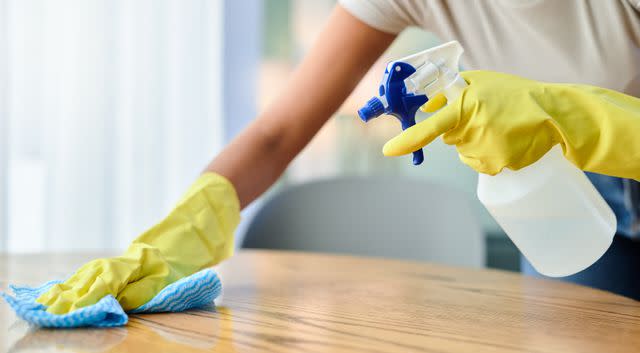Here's What You Can (and Should Never) Clean with Bleach
Chlorine bleach is a powerful disinfectant, but it can cause damage and create safety hazards when used incorrectly.
Bleach is a powerful cleaning and whitening agent used to disinfect household and commercial surfaces, eliminate mold and mildew growth in textiles and hard surfaces, and whiten laundry. It is especially useful for disinfecting after a natural disaster, fire, or flood, and it is critical for the emergency disinfection of drinking water.
However, chlorine bleach is not safe to use on many fabrics and materials, and it can be hazardous when used incorrectly. This guide explains the difference between chlorine bleach and oxygen bleach/color-safe bleach, as well as what is safe and appropriate to clean with bleach.

PeopleImages / Getty Images
Chlorine Bleach vs. Oxygen Bleach/Color-Safe Bleach
Chlorine bleach, also called sodium hypochlorite bleach or liquid household bleach, is what we tend to think of when we say “bleach.” It disinfects, cleans, and whitens, and it causes color loss—a bleaching effect—in colored textiles.
Oxygen bleach, also called color-safe bleach or non-chlorine bleach, typically comes in powder form, although liquid oxygen bleach is also available. The active ingredient in oxygen bleach is usually hydrogen peroxide, although some formulas contain sodium percarbonate or sodium perborate. Oxygen bleach can safely be used in laundry and on many hard and soft household surfaces, including upholstered furniture, carpets and rugs, and grout. Oxygen bleach does not have the strong odor we associate with chlorine bleach.
What ‘Bleach-Safe’ Means
The term “bleach-safe” indicates that a garment can be washed with chlorine bleach without the risk of color loss or damage to the fabric.
The best way to determine if something is bleach-safe is to consult its care label. There are three fabric care symbols associated with the use of bleach:
Triangle: The garment can be washed with any type of bleach.
Triangle with two parallel lines inside: The garment can be washed with non-chlorine bleach only.
Solid triangle with an X through it: Do not bleach.
In addition to consulting an item’s care tag, a colorfastness test can determine if something is bleach-safe. To test for colorfastness, dilute 2 tsp. of chlorine bleach in ¼ cup of water and apply a drop of the bleach solution to an inconspicuous part of the item. After 1 minute, rinse the bleach solution and blot the area dry; if there is no change in the color, the item is bleach-safe.
What to Know Before Cleaning with Bleach
Recommended dilution ratios vary, and different jobs call for different dilution ratios. Clorox has a helpful bleach dilution ratio chart. The Centers for Disease Control (CDC) recommends following package directions for preparing a diluted bleach solution; absent instructions, the CDC offers the following ratios for making a bleach solution:
5 Tbsp. of bleach per gallon of room-temperature water or
4 tsp. of bleach per quart of room-temperature water
Never mix chlorine bleach with ammonia, vinegar, other acids, including lemon juice, or any products that contain those ingredients. Doing so will result in toxic chemical fumes that can sicken or kill humans and animals.
When cleaning with bleach, wear protective gloves and work in a well-ventilated area; wearing eye protection or a mask are other recommended precautions, especially for those with respiratory issues.
Related: 7 Ways to Clean Your Bathroom With Bleach
When to Use Chlorine Bleach or Oxygen Bleach/Color-Safe Bleach
Chlorine bleach can be used to disinfect surfaces and textiles, whereas oxygen bleach does not have disinfecting properties. However, chlorine bleach should only be used on bleach-safe items and should not be mixed with ammonia, vinegar, or other acids, or any household cleaners that contain them.
What Can Be Cleaned with Chlorine Bleach
Chlorine bleach is safe to use when cleaning the following:
Mold, mildew, and Serratia marcescens (a.k.a. “pink mold”)
Countertops, cutting boards, and other food prep surfaces
White porcelain and glass items, including tableware and household fixtures that need brightening or stain removal
Trash cans and compost bins
Outdoor surfaces, including brick, slate, concrete, and wood
Gardening tools
Plastic toys
Bleach-safe white launderable clothing and household goods
What Can’t Be Cleaned with Chlorine Bleach
When using chlorine bleach for laundry, always check the care tag for guidance on whether a garment is bleach-safe. In general, wool, silk, cashmere, mohair, leather, spandex, fleece, and microfiber should not be exposed to chlorine bleach.
While chlorine bleach is recommended for disinfecting many common household surfaces, it should not be used on the following materials and items:
Metals, including stainless steel and aluminum
Sealed marble, granite, and natural stone
Painted wood
Electronics, including cell phone and tablet screens
Clothing and household goods that are not bleach-safe
Food
For more Better Homes & Gardens news, make sure to sign up for our newsletter!
Read the original article on Better Homes & Gardens.

